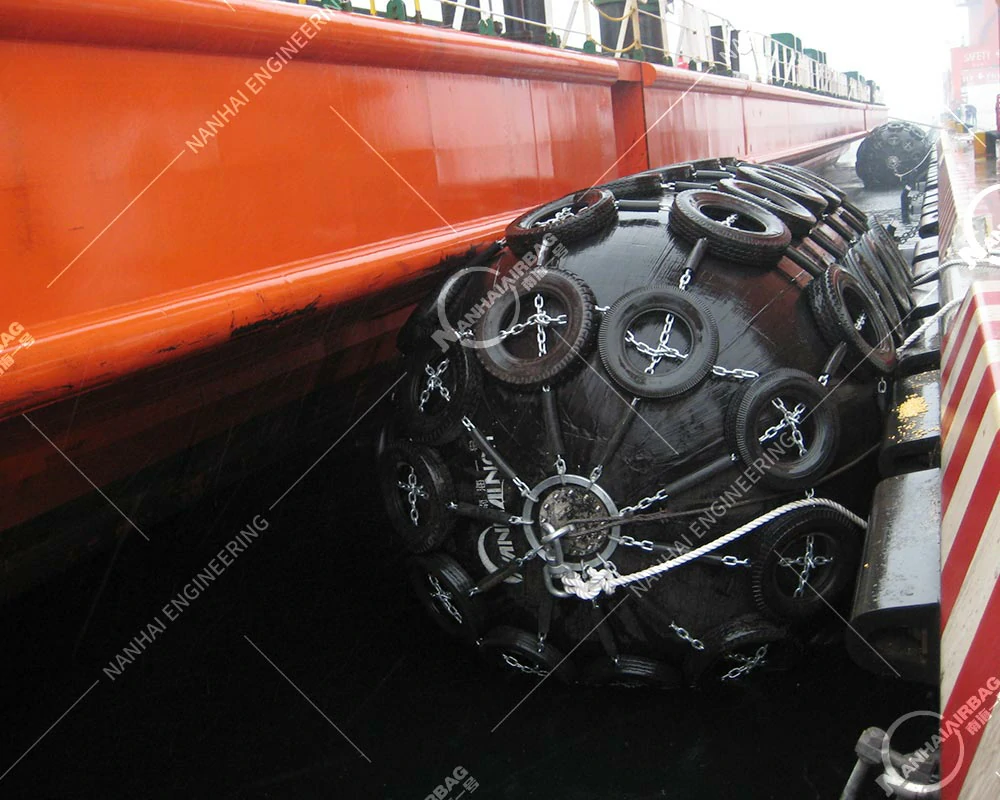Buoyancy Rubber Airbags: The Unsung Hero Keeping Maritime Operations Safe (and Profitable)
14/10/2025Fixed Rubber Fenders: The Quiet Guardians of Every Safe Marina (and Why You Need Them Yesterday)
21/10/2025

Imagine this: A 40-foot fishing boat slams into your marina’s dock on a windy afternoon. Instead of hearing a sickening crackof fiberglass on concrete, you watch the boat bounce gently—no damage, no panic, just a quiet “thud.” What’s the secret? Pneumatic rubber fenders—those squishy, air-filled rubber tubes lining your dock that turn hard impacts into harmless hugs. And if you think they’re just “nice to have”? Let me change your mind—fast.
What Even ArePneumatic Rubber Fenders?
Let’s break it down simply: Pneumatic rubber fenders are cylindrical (or sometimes rectangular) marine fenders made from thick, layered rubber (usually natural rubber with polyester reinforcement) that’s inflated with compressed air. Think of them like giant pool floats for boats—but way tougher. When a ship, boat, or barge hits them, the air inside compresses, spreading the impact force across the entire surface of the fender. This absorbs 80–90% of the shock—way more than solid rubber fenders—so nothinggets damaged.And here’s the kicker: They’re adjustable. Need more cushioning for a bigger boat? Add air. Need to fit a tight space? Let some out. They’re not just fenders—they’re smart, flexible protection.
Why This Is Non-Negotiable Right Now (And Not Just for Big Ports)
Let’s cut to the chase: Traditional dock protection is failing us—and costing a fortune.Last year, a small marina in Maine had three docks destroyed by a single storm. Why? Their solid rubber fenders cracked under the force of a 30-foot lobster boat slamming into them. Repair costs? $150,000—and that’s not including lost revenue from closed slips. Or take Florida’s Tampa Bay: A fishing fleet lost two boats to hull damage after hitting rigid fenders during Hurricane Idalia.Climate change is making storms stronger, ships are getting bigger (the average container ship is now 400 meters long!), and marinas/docks are busier than ever. Pneumatic rubber fenders aren’t a luxury—they’re insurance for your assets. They handle sudden impacts, rough weather, and even accidental bumps from inexperienced boaters—all without breaking a sweat.
Wait—Why Choose Pneumatic Over AnyOther Marine Fender?
You’ve heard of rubber fenders. You might even know marine airbags. But pneumatic rubber fenders? They’re in a league of their own. Let’s compare:
- •vs. Solid Rubber Fenders: Solid fenders transfer impact straight to the dock/boat. Pneumatic ones spreadit—so no more cracked hulls or shattered concrete.
- •vs. Marine Airbags: Marine airbags (like those for ship launching) are for heavy lifting/stabilization. Pneumatic fenders are for everyday protection—docks, marinas, piers.
- •Portability: You can move pneumatic fenders anywhere—tie them to a dock piling, drop them in front of a mooring, or even take them on a boat trailer. Solid fenders? Bolted down. Forever.
And here’s the best part: They last longer. A good pneumatic fender will hold up for 10–15 years with basic maintenance. Solid fenders? Replace them every 3–5 years.
Real Talk: How One Marina Saved $500K in a Year
Let’s use a real example—because numbers don’t lie. The Camden Harbor Marina in Maine switched from solid rubber fenders to pneumatic ones in 2023. Here’s what happened:
- •90% less dock damage: No more cracked fenders or scraped hulls.
- •$500K saved: From avoided repairs and lost slip rentals.
- •Happier boaters: No more “sorry about your boat” conversations with angry customers.
The marina manager told us: “We used to budget 200Kayearforfenderrepairs.Now?Wespend20K on maintenance. It’s a no-brainer.”
People Also Ask
We get these questions daily—let’s answer them so you don’t have to Google:
Q: How do pneumatic rubber fenders work exactly?
A: Compressed air inside the fender acts like a shock absorber. When hit, the air compresses, spreading the impact force across the rubber layers. This reduces shock to both the boat and the dock—so nothing gets damaged.
Q: Are pneumatic rubber fenders better than regular rubber fenders?
A: 100% yes—if you care about protection and cost. Regular fenders are rigid and crack easily. Pneumatic ones flex, absorb more impact, and last longer.
Q: What size pneumatic fender do I need for my dock?
A: It depends on boat size and traffic. For small boats (20–30 feet), go with 1–1.5m fenders. For larger vessels (40+ feet), use 2–3m fenders. Always check with a manufacturer for custom recommendations.
Q: Are pneumatic rubber fenders eco-friendly?
A: Yes—and no, but in a good way. High-quality ones use non-toxic rubber that won’t leach chemicals. And since they last longer, you’re not replacing them every few years (less waste!).
Q: Can I use pneumatic fenders for offshore boats?
A: Totally. Many fishing fleets use them for mooring offshore—they handle rough waves and strong winds better than solid fenders.
Final Thought: Stop Wasting Money on Broken Fenders
Pneumatic rubber fenders aren’t just another piece of marine equipment—they’re a game-changerfor anyone who owns a dock, runs a marina, or even just docks their boat regularly. They save you money, keep your assets safe, and let you focus on what matters: boating, fishing, or running your business.Ready to upgrade? Start by measuring your dock and figuring out which boat sizes you need to protect. Then, reach out to a reputable manufacturer—they’ll help you pick the right fenders (and even install them if you want).Your dock (and your wallet) will thank you.Keywords: pneumatic rubber fenders, marine fenders, rubber fenders, marine airbags, dock protection, marina safety
